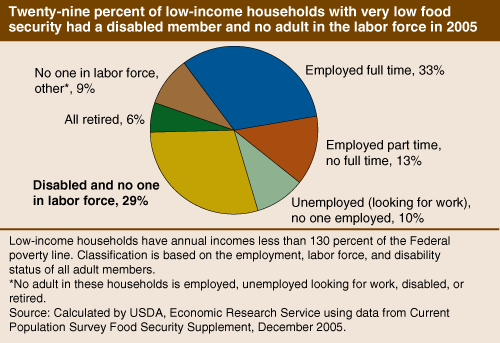Disability Is an Important Risk Factor for Food Insecurity
- by Mark Nord
- 2/1/2008
Food security—consistent access to adequate food for active, healthy living—is an important foundation for good nutrition. ERS monitors the food security of U.S. households, giving particular attention to low-income households.
In 2006, 89 percent of the Nation’s households were food secure through-out the year. The remaining 11 percent (about 12.6 million households) were food insecure, meaning that they had difficulty at times during the year meeting basic food needs due to lack of money or resources for food. About one in three food-insecure households, or 4 percent of all U.S. households, had very low food security at some time in 2006. In these households, some members had reduced food intake at times, and their normal eating patterns were disrupted.
Research findings suggest that a work-limiting disability substantially increases the risk of food insecurity for low-income families. Thirty-seven percent of all low-income households with very low food security had at least one working-age adult who was unable to work because of a disability. In addition to reducing or preventing employment of the disabled individual and incurring burdensome medical costs and other expenses, having a household member with a work-limiting disability can reduce the work opportunities and hours of other adult caretakers.
A recent ERS study examined the food security, employment and disability status, demographic makeup, and other characteristics of low-income households to better understand how USDA food and nutrition assistance programs serve them. Data on households’ food security as well as their economic and demographic characteristics were provided by the nationally representative Current Population Survey Food Security Supplement for 2005. The prevalence of very low food security was calculated for low-income households (annual income less than 130 percent of the poverty line) in selected demographic and economic groups.
Households with no member in the labor force and at least one working-age adult who was out of the labor force because of a disability had the highest rate of very low food security (23 percent). They comprised 29 percent of all low-income households with very low food security. An additional 8 percent also had a member out of the labor force due to disability but had one or more other adult members in the labor force.
The food security survey does not collect information on participation in disability programs. Therefore, this study could not determine to what extent very low food security in households with a disabled member reflects ineligibility for disability assistance, inability or unwillingness to access those programs, or limited support from programs in which they do participate. Strengthening assistance programs for the disabled may be an important strategy for improving food security in this economically vulnerable population.
This article is drawn from:
- Nord, M. (2007). Characteristics of Low-Income Households With Very Low Food Security: An Analysis of the USDA GPRA Food Security Indicator. U.S. Department of Agriculture, Economic Research Service. EIB-25.
- Nord, M., Andrews, M. & Carlson, S. (2007). Household Food Security in the United States, 2006. U.S. Department of Agriculture, Economic Research Service. ERR-49.


